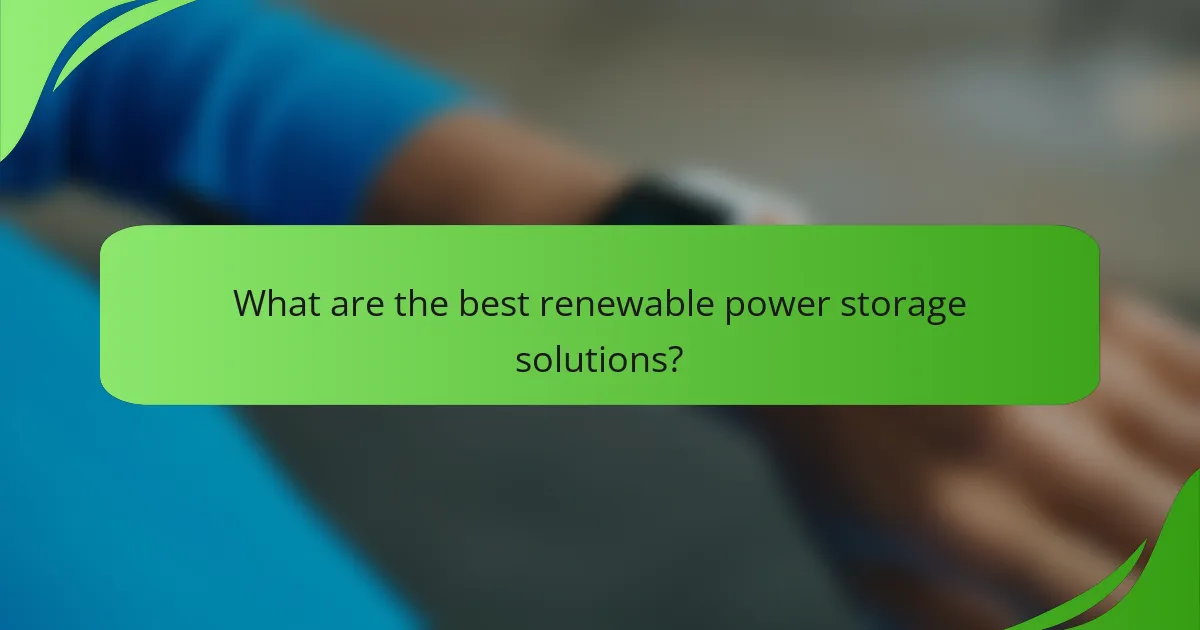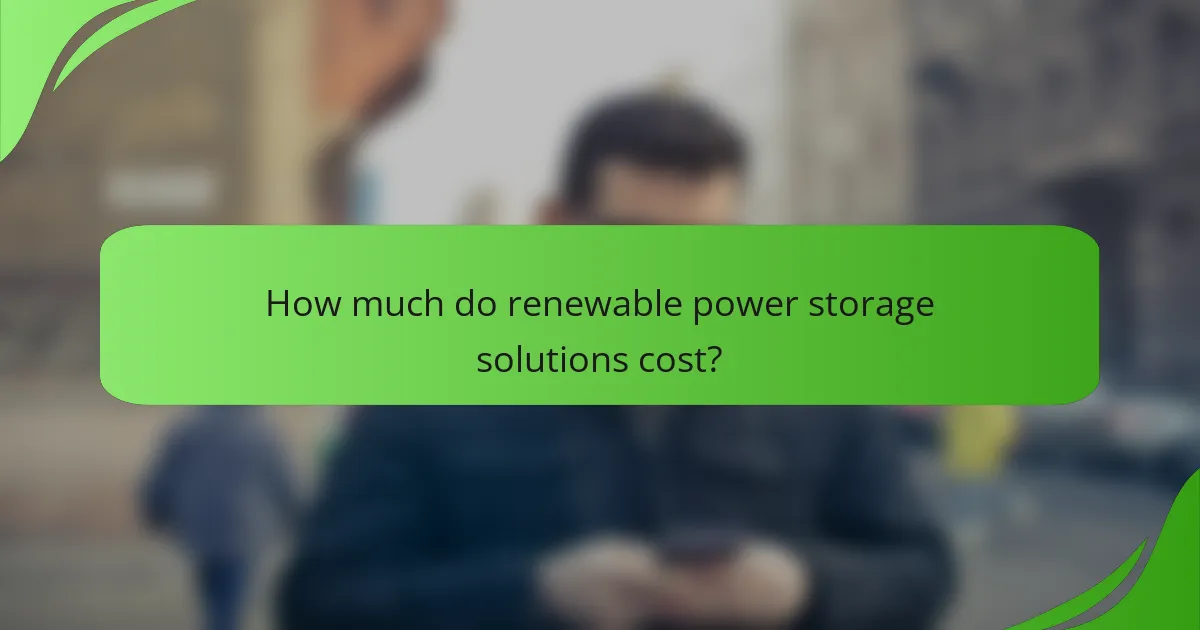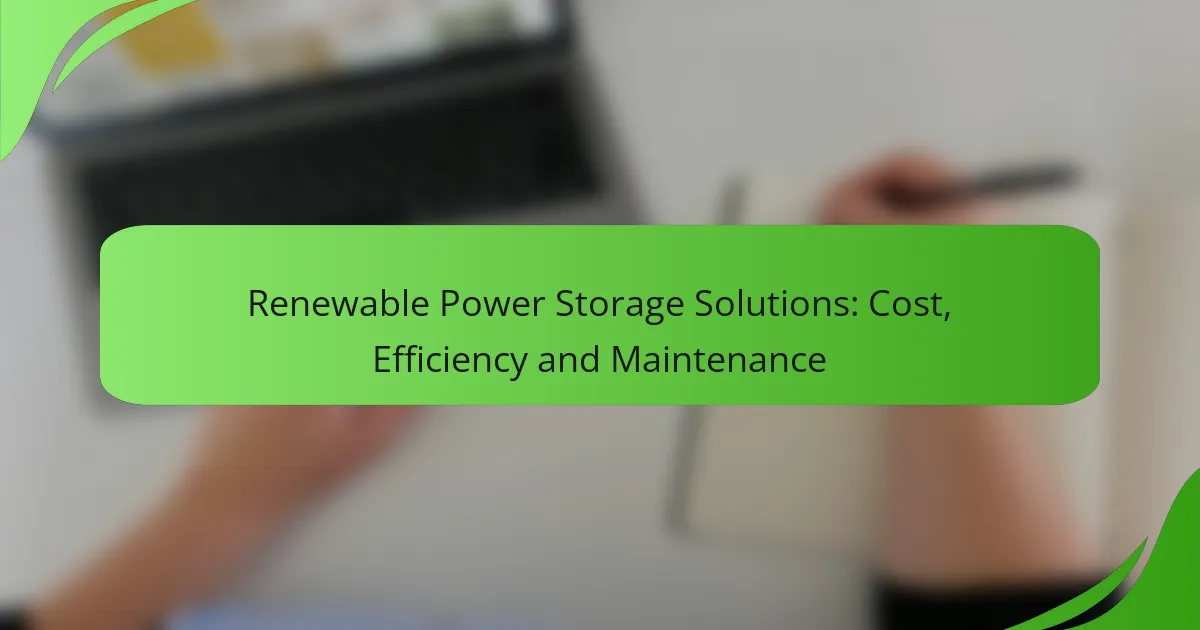Renewable power storage solutions play a crucial role in optimizing the use of clean energy sources, with options such as lithium-ion batteries, flow batteries, and pumped hydro storage each offering distinct advantages. The cost, efficiency, and maintenance requirements of these technologies vary widely, influencing their suitability for various applications. Understanding these factors is essential for making informed decisions in the transition to sustainable energy systems.

What are the best renewable power storage solutions?
The best renewable power storage solutions include lithium-ion batteries, flow batteries, pumped hydro storage, compressed air energy storage, and solid-state batteries. Each option has unique characteristics that affect cost, efficiency, and maintenance, making them suitable for different applications in renewable energy systems.
Lithium-ion batteries
Lithium-ion batteries are widely used for energy storage due to their high energy density and efficiency. They are commonly found in electric vehicles and grid storage applications, offering a lifespan of around 5 to 15 years depending on usage and conditions.
When considering lithium-ion batteries, it’s essential to evaluate factors such as initial costs, which can range from 300 to 700 USD per kWh, and their environmental impact, particularly regarding recycling and resource extraction.
Flow batteries
Flow batteries utilize liquid electrolytes to store energy, allowing for scalable and long-duration storage. They are particularly advantageous for large-scale applications, with a lifespan that can exceed 20 years and minimal degradation over time.
While the upfront costs can be higher than lithium-ion options, typically around 500 to 800 USD per kWh, flow batteries offer benefits such as easy maintenance and the ability to discharge energy over extended periods, making them suitable for renewable energy integration.
Pumped hydro storage
Pumped hydro storage is a mature technology that uses gravitational potential energy to store electricity. Water is pumped to a higher elevation during low demand and released to generate power when needed, providing large-scale energy storage with high efficiency rates of about 70-90%.
This solution requires significant infrastructure and suitable geographical locations, making it less accessible for some regions. However, it remains one of the most cost-effective options, with costs typically ranging from 100 to 200 USD per kWh over its lifespan.
Compressed air energy storage
Compressed air energy storage (CAES) involves compressing air in underground caverns or tanks to store energy. When electricity is needed, the compressed air is heated and expanded to drive turbines, generating power. This method can store energy for hours to days.
CAES systems can be capital-intensive, with costs ranging from 200 to 400 USD per kWh, but they offer the advantage of long-duration storage and can be integrated with renewable sources like wind and solar for grid stability.
Solid-state batteries
Solid-state batteries are an emerging technology that replaces the liquid electrolyte in traditional batteries with a solid electrolyte. This design enhances safety, energy density, and longevity, potentially offering a lifespan of over 20 years.
Though still in development, solid-state batteries could significantly reduce costs and improve performance compared to lithium-ion batteries, making them a promising solution for future renewable energy storage needs. Current estimates suggest they may reach competitive pricing levels within the next decade.

How much do renewable power storage solutions cost?
The cost of renewable power storage solutions varies significantly based on the technology used, installation scale, and specific requirements. Generally, initial investments can range from thousands to millions of dollars, with ongoing maintenance and operational costs also influencing total expenditure.
Initial investment for lithium-ion batteries
Lithium-ion batteries are among the most popular storage solutions, especially for residential and commercial applications. The initial investment typically ranges from $400 to $700 per kilowatt-hour (kWh) of storage capacity, depending on the system’s size and complexity.
While the upfront costs can be high, lithium-ion batteries offer quick response times and high efficiency, making them suitable for applications requiring rapid energy discharge. However, potential buyers should consider the lifespan and degradation rates, which can affect long-term value.
Cost comparison of flow batteries
Flow batteries can provide significant advantages in terms of cycle life and depth of discharge, which can lead to lower costs over time. When evaluating options, consider the specific energy needs and whether the longer lifespan justifies the higher initial investment.
Pricing for pumped hydro storage
Pumped hydro storage is one of the most established and cost-effective large-scale storage solutions, with costs typically ranging from $1,000 to $5,000 per installed kilowatt. The price varies based on location, geological conditions, and infrastructure requirements.
This technology relies on the gravitational potential energy of water, making it highly efficient for storing large amounts of energy. However, the initial investment can be substantial, and suitable sites are often limited, which can affect feasibility.
Long-term savings with compressed air systems
While the upfront costs are lower, the efficiency of compressed air systems can be lower than that of batteries. However, they can provide significant long-term savings, especially for large-scale energy storage needs, due to their ability to store energy for extended periods without degradation.

What is the efficiency of renewable power storage systems?
The efficiency of renewable power storage systems varies significantly based on the technology used. Generally, efficiency refers to how much of the stored energy can be retrieved for use, with different systems exhibiting distinct performance characteristics.
Efficiency rates of lithium-ion batteries
Lithium-ion batteries are among the most widely used energy storage solutions, boasting efficiency rates typically between 80% and 95%. This means that a substantial portion of the energy stored can be utilized, making them ideal for applications like electric vehicles and grid storage.
However, factors such as temperature, charge cycles, and battery age can influence these efficiency rates. Regular maintenance and optimal operating conditions can help maintain high performance.
Flow battery efficiency metrics
Flow batteries generally have efficiency rates ranging from 60% to 80%. Their design allows for scalability and long-duration storage, making them suitable for renewable energy applications like solar and wind energy integration.
While they may not match lithium-ion batteries in terms of efficiency, flow batteries offer advantages in terms of longevity and the ability to decouple power and energy capacity, which can be beneficial for certain applications.
Pumped hydro storage efficiency
Pumped hydro storage systems typically achieve efficiency rates between 70% and 90%. This method involves pumping water to a higher elevation during low energy demand and releasing it to generate electricity during peak demand.
While highly efficient, the feasibility of pumped hydro depends on geographical factors and the availability of suitable sites, which can limit its widespread adoption in some regions.
Factors affecting compressed air efficiency
Compressed air energy storage systems usually exhibit efficiency rates of about 50% to 70%. The efficiency can be affected by factors such as the method of compression, heat recovery systems, and the design of the storage facility.
Improving efficiency in compressed air systems often involves integrating heat recovery technologies and optimizing the compression and expansion processes, which can significantly enhance overall performance.

What are the maintenance requirements for renewable power storage?
Maintenance for renewable power storage systems is crucial to ensure optimal performance and longevity. Requirements vary by technology, with different practices needed for lithium-ion batteries, flow batteries, and pumped hydro systems.
Maintenance for lithium-ion batteries
Lithium-ion batteries require regular monitoring of their charge cycles and temperature levels to maintain efficiency. It’s essential to keep them in a controlled environment to prevent overheating, which can reduce lifespan and performance.
Routine checks should include inspecting connections for corrosion and ensuring that battery management systems are functioning correctly. Cleaning terminals and ensuring proper ventilation can also help avoid common issues.
Flow battery upkeep
Flow batteries need periodic checks of their electrolyte levels and chemical balance, as these directly affect performance. Regular maintenance includes replacing the electrolyte solution and inspecting pumps and valves for leaks or blockages.
It’s advisable to monitor the system for any signs of wear and tear, particularly in the membranes and electrodes, which may require replacement every few years to maintain efficiency.
Pumped hydro maintenance practices
Pumped hydro systems involve significant mechanical components that require regular inspections and maintenance. This includes checking the integrity of dams, turbines, and pumps to prevent failures.
Routine maintenance should also focus on the water quality and flow rates, ensuring that sediment buildup does not hinder operations. Regular assessments can help identify potential issues before they lead to costly repairs.
